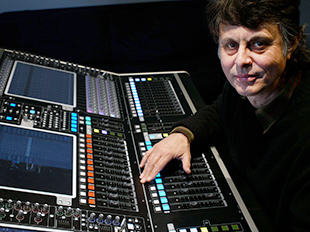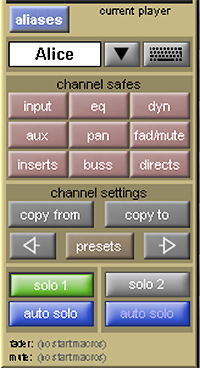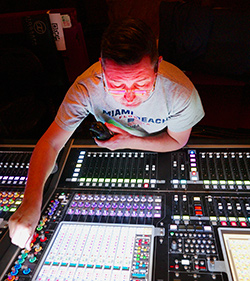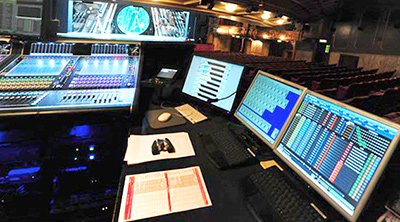![]() ‘I said I’d done some work with Soundcraft and Cadac, and I had a big folder of information. Would they be interested in evolving something specifically for use in the theatre?
‘I said I’d done some work with Soundcraft and Cadac, and I had a big folder of information. Would they be interested in evolving something specifically for use in the theatre?
‘James put me in touch with the people who write DiGiCo’s software. They came to London and we went to see several shows that night – and I watched while the colour drained from their faces…’
Autograph’s Andrew Bruce is recounting the sequence of events that led up to DiGiCo’s present domination of theatre sound mixing. DiGiCo had unveiled the D5 Live console at the 2002 Plasa show in London, and Bruce had been told by fellow theatre sound designer Bobby Aitken that he should check it out. He struck up a conversation with DiGiCo MD James Gordon: ‘I’m from a theatre company, and we’ve got a potential new use for your console… have you thought of the theatre?’
 Gordon despatched the software team to find out what would be required: ‘They started off at Chitty Chitty Bang Bang, which had a really big Cadac J-Type console, and watched while the operator ran 200 cues and a lot of sound effects,’ Bruce says. ‘She was up and down the console following every line – and they said, “we had no idea you did all this, we always thought theatre was quite easy”’.
Gordon despatched the software team to find out what would be required: ‘They started off at Chitty Chitty Bang Bang, which had a really big Cadac J-Type console, and watched while the operator ran 200 cues and a lot of sound effects,’ Bruce says. ‘She was up and down the console following every line – and they said, “we had no idea you did all this, we always thought theatre was quite easy”’.
What had shocked the DiGiCo team was the line-by-line mixing technique used by theatre sound engineers. This entails learning the full show script and managing mic levels and EQ for every player – as well as any sound effects – to ensure that only active mic channels are open and the remainder fully muted.
‘In orchestral recording, you are very unlikely to completely remove mics that are not in use,’ Bruce says, by way of comparison with life in the recording studio. ‘You may dip them but you will not take them out because the ambience would change dramatically if you were to do so. That is completely different on stage.
‘With potentially 35 people on stage, every one wearing an omnidirectional mic and all facing in different directions, with a PA that is only five metres away, albeit facing in a different direction, you cannot afford to leave any unused mics up at all. So you’re not just following every line, you are killing stone dead every mic that is not literally in use at this point. Mics do not dip, they go completely mute, otherwise you have potentially 50 mic sources all contributing enormous amounts of audio contamination.
‘Avoidance of comb filtering is an art form in itself. You often get two singers with omnidirectional mics, facing each other, a metre apart or less if they are in an embrace, singing line-by-line or harmonising while moving infinitesimally but significantly. If you fail to clock what’s happening there, you will get the most awful comb filtering going on. So there are any number of techniques and devices that are employed by operators and designers to counter that.
‘The most rudimentary one is just dipping the least important mic, as long as the actors are close enough together. You will get some sort of balance that way, as long as you dip the mic on the person with the stronger voice. But that might only be for a few words, and then as they move away or turn away, you’ve got to be ready to bring the other mic back.
‘This is beyond the scope of any automation because they may not turn away on the same word, so the operator has to be watching what they’re doing and the balancing is absolutely manual.’
A digital console’s ability to map channels to the surface offers two immediate and dramatic benefits. It simultaneously pulls groups of channels together under an operator’s hands instead of leaving them spread across a massive console and allows the other channels to be ‘hidden’, reducing the number of theatre seats that have to be sacrificed to accommodate it. In addition, storing channel settings allows what DiGiCo has termed Aliases (originally coined to reflect its relevance to the theatre) to be created to accommodate changes in EQ made necessary by the use of hats.
Getting ahead
 Hats are among the most common props used by theatre actors and are removed, replaced and changed many times in the course of most theatre productions. The effect of changing the immediate acoustic environment of a miniature lavalier microphone requires dramatic changes in equalisation to compensate. While it is beyond the capabilities of a mixer to reliably make on-the-fly adjustments to an analogue console, an alias can be quickly called up to bring remedial EQ.
Hats are among the most common props used by theatre actors and are removed, replaced and changed many times in the course of most theatre productions. The effect of changing the immediate acoustic environment of a miniature lavalier microphone requires dramatic changes in equalisation to compensate. While it is beyond the capabilities of a mixer to reliably make on-the-fly adjustments to an analogue console, an alias can be quickly called up to bring remedial EQ.
‘That system of aliases is the other absolute priority for the theatre, because hats are a fact of life that come and go with incredible regularity,’ Bruce confirms. ‘There are some shows where people use hats from beginning to end – and they don’t just take them on and off, they take them off in order to put another one on. I did a show where that was the case and it was a nightmare. A lot of your session programming is to do with placing the right aliases in the right cues, building extra cues to cope with the change of hats, and so on. You have to deal with hats…’
And you also have to deal with changes to the cast, as Bruce explains.
‘I told James early on in the D5T development, that the one thing all designers were requesting and the single feature thing that would ingratiate DiGiCo to all theatre sound mixers is to recognise and provide for the fact that, if you include understudies, there are always four people playing the same principal part, and to store settings for every single one of those actors. And future players – if the play runs for years and years, those actors will have been replaced by another four, only to have one of the original four return some years later because he’s made it big in the world of TV and has come back to do a guest spot. And that’s not just for actors, but for musicians as well.
‘Being able to store all the alias settings for an unlimited number of people and access them literally during the show without having to stop or call a halt in any way, makes DiGiCo a de facto standard for theatre. It took a while because it’s a really complicated bit of programming, but they did just that.
‘That allows the sound mixer to instantly do a better job. While he didn’t have time to change EQ for a hat, that was the most noticeable thing to everybody in the auditorium. And making changes of player mid-show is a huge plus – you can now throw somebody on and they sound exactly as good as they did last time.
‘No other mixer manufacturer does either aliases or players.’
Time for ‘T’
 Recognising the D5’s theatre potential, Bruce called in as many sound designers and operators as he could to gather their input and see if they shared his enthusiasm. They did, and their thoughts added to the inspiration behind what was to become the ‘T’ version software although he remained the primary coordinator and sense-checker. He recalls the series of ‘very intense’ discussions that followed, and the description of the theatre process he outlined to enable the team to develop the ‘T’ software. So while the DiGiCo hardware promised to accommodate theatre-style mixing, the software required a further year’s investment.
Recognising the D5’s theatre potential, Bruce called in as many sound designers and operators as he could to gather their input and see if they shared his enthusiasm. They did, and their thoughts added to the inspiration behind what was to become the ‘T’ version software although he remained the primary coordinator and sense-checker. He recalls the series of ‘very intense’ discussions that followed, and the description of the theatre process he outlined to enable the team to develop the ‘T’ software. So while the DiGiCo hardware promised to accommodate theatre-style mixing, the software required a further year’s investment.
‘There was very little time for beta testing before we had the opportunity to make the first foray,’ Bruce says. ‘This coincided with the move of Les Mis from the Palace Theatre, where it had been for 19 years on an A-Type Cadac, to the Queen’s, which is a much smaller theatre and the producer needed all the seats he could get. It was a perfect opportunity because it was a show we knew very well – we knew where all the cue points had to be and we knew how it had to sound, and it was the producer who had been on at us all along to make this change to digital. It was a controlled environment and we had a number of previews to refine the programming and to get used to using it ourselves.
‘After all this intense work and very short show programming time, there were still things that were being refined and bugs that were being fixed, and on the day of our first preview, we had two software updates – one in the morning and one just after lunch, to get rid of a major problem that we were encountering.
‘It was a scary day, but we did the first preview, with no problems.
‘The fact that we could phone through and describe what was happening – they got it, they altered it, they sent it back to us and we loaded it, all in the course of one day – encapsulates DiGiCo to me.’
What began as additional software for the original DiGiCo D5 console was to take a significant step forward with the subsequent SD7 desk.
‘The D5T was very much our prototype, because they couldn’t make risky changes to the core software of a platform that was already out there, and the hardware could not be adapted to take on some of the new features,’ Bruce explains. ‘All the theatre stuff in the D5 was bolted on to the core software, routines that made the D5 work in a different way. Some were totally successful throughout their life, but some made interrogation of programming very challenging. We quickly learned to treat the most troublesome ones with great care.
‘The most risky routine was for external programming of control group membership.’

With the SD platform, all of the things that Bruce, the other sound designers and DiGiCo had developed were an integral part of the desk’s software, including access to a session at a much deeper level than on the D5. Among other things, this allows on-line access to a show’s session programming without interfering with a performance, using an additional surface or computer.
‘With the SD7, we always make sure that there’s a large and very comprehensive workstation networked to the console that allows you to do programming particularly of control group membership,’ Bruce explains. ‘This harks back to a route we developed for the SAM automation system with Cadac, which is a spreadsheet that allows you to assign control group members using individuals’ names and aliases from a list – you can program a person for a run of cues then insert their hat alias. You can also name and assign at the same time, unlike on standard consoles where you laboriously decide who is going to be in a control group, then name it, then do it for all subsequent cues– which is very time consuming. We can’t afford that time; we’ve go to be able to program and go or program ahead while the operator is working without having to go off line.
‘These principles came together in the D5T, but were never particularly reliable because it was done using a completely separate program that tried to slot its information into the program running on the D5, and there were frequent conflicts. But it did demonstrate that being able to program control group membership instantly, and name people and groups, was a huge time-saver.
‘Another thing that sounds ridiculous now, was that nobody had considered that we work entirely from scripts. For weeks and weeks at the start of a production, and then weeks again when the second and third operators are learning the show. The fact is that the script resides right in front of the control groups, so the master screen and the cue list are not visible. The script trolley needs to be there and it needs to be visible, but you can’t keep moving it while you’re following lines in order to see which cue you’re in or to allow the sound designer to get at the matrix. It is imperative that you have the ability to make those adjustments on a workstation – or an EX007 – so that you don’t interrupt the flow of the sound mixer. If you do, you are compromising the most important thing, which is not missing lines.’
Mixing the future
After a number of false starts, digital mixing has won a justifiable place in theatre sound. It allows an operator to do a better job more comfortably, and to deliver a better sound experience to the audience. Perhaps ironically, Bruce believes that its benefits are largely lost on both cast and musicians. But a show’s audience and its producers are more important benefactors – regardless of the scale of a production, as ‘T’ software runs on a range of DiGiCo’s consoles.
From here, Bruce anticipates a more sedate rate of innovation:
 ‘I can’t predict any changes that we can’t already accommodate or that aren’t already in the pipeline,’ he says. ‘Everything we do is dependent upon what actors and musicians give us, and we can keep up with that.
‘I can’t predict any changes that we can’t already accommodate or that aren’t already in the pipeline,’ he says. ‘Everything we do is dependent upon what actors and musicians give us, and we can keep up with that.
‘At the moment, there are a couple of things where we’ve hit the end stop of the technology. The FPGAs in the console are limited by the number of wires that can be connected to them, or so I’m told. A couple of things we’ve asked for are possible to do within the FPGA but there are currently no more routes in and out.’
That said, there are things in development that promise further benefits.
‘During the course of programming a show, you will find things that are limited to one cue, instead of tracking through a number of cues – someone leans against a wall while singing three lines of a song – it’s like putting a hat on but it only happens once and it’s not worth creating an alias just for that. If the director decides he doesn’t want the actor to do that after all, you’re then faced with having to remove whatever compensation you added by going into the session software. But you may also have other temporary settings in that cue that are for one use only that you don’t want to restore. At the moment you can only do all or nothing, so we want to expand the way in which you can edit the cue. But there are very few of those things left, and I think that it will be possible to do them within the current platform.’
There is also the opportunity to incorporate new routines into the console software, among the most recent of which is the addition of Waves plug-ins.
‘Anybody who comes from the studio world can bring their plug-ins with them if they don’t have the time or the inclination to look into what the various things that are already on the desk can do,’ Bruce says. ‘But practically speaking, you’re limited to the master screen which is located, you guessed it, beneath the script – so to put Waves there for a sound designer who is new to theatre is quickly going to lead to conflict. You also need to run Waves on both of the console engines in case of an automatic switchover.
‘Waves is very welcome but it needs to be treated very carefully.
‘Another thing that people talk about introducing onto the console, but that I think suffers from the same problem, is spatial processing, such as TiMax. Once again, you’re concentrating so much into a small space that it may be impossible to make use of it. Is it better to keep things like these as outboard?’
And the development effort continues…
‘We’re stuck with the numbers of layers and banks and those can get pretty full these days, so the next platform will presumably give us more layers and banks – and software derives from the abilities of the hardware. There is a folder of things that keep getting carried forward from one wish list to the next, basically things that won’t make it onto this platform but will make it onto the next, and will make life even easier…’
See also:
Theatre Sound: Towards Digital Mixing
Staging a Musical: The Sound Perspective
(The sound role in preparing for a major theatre production)
Theatrical Address: Loudspeakers for Theatre
(The history and development of theatre loudspeaker systems)
Pioneering theatre sound designer Andrew Bruce is the founder and owner of Autograph. He began his career at the Glyndebourne Festival Opera before becoming Head of Sound at the Royal Opera House, Covent Garden. His extensive musical credits include Evita, Cats, Les Misérables and Miss Saigon.